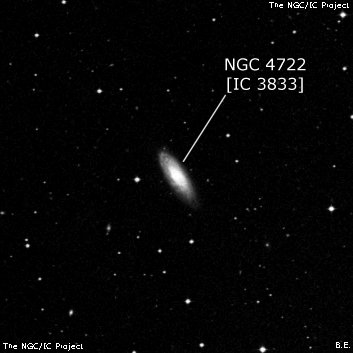NGC/IC Project Restoration Effort
(This is a very very beta version)
NGC4722


Basic Information
Location and Magnitude
Right Ascension: 12:51:32.3
Declination: -13:19:48
Constellation: CRV
Visual Magnitude: 12.8
Historic Information
Discoverer: Tempel
Year of discovery: 1882
Discovery aperture: 11.0
Observational
Summary description: 2 vF, vS, f III 356
Sub-type: S0-a
Corwin's Notes
=====
NGC 4722 and 4723. These are two nebulae found by Tempel, described in his
fifth paper simply as "Following [GC] 3244 [NGC 4714] are two more small
class III nebulae which I have sketched, but have still not been able to
measure" (my translation of his note in German). Dreyer adopted the north
polar distance of N4714 and added a bit to its RA (with a plus-minus sign to
indicate the uncertainty) to arrive at an approximate position for Tempel's
two nebulae.
Bigourdan was the next to look for them, but his two measurements of "NGC
4722" fall in a blank region of the sky east of NGC 4714. His table is pretty
well scrambled at this point, with the declination of his comparison star
given only as "+27" and the footnote "Position deduced from that of the
nebula, given in the NGC." He has no errata, so just what his comparison
object actually was is still a mystery. He's a bit better for N4723 (N4714 is
the comparison object), but he only estimates the offset. The nearest object
to his estimated position for that is a faint star. In the end, he's no help
here. (One other curiosity: he claims, in the "Other Observer's" column that
N4722 was seen at Leander McCormick. But the object is not listed in any of
the LM papers on nebulae.)
He also found his 302nd new object, which became IC 3833, in the area. He
gave no indication, though, that it might be one of the NGC objects (see the
IC number for a bit more information about this).
That was left to Herbert Howe, who independently discovered and measured the
same galaxy that Bigourdan picked up. Howe suggested, in a roundabout way,
that it might be one of NGC 4722 or 4723. Howe's comment made it into the IC2
Notes, but Dreyer did not notice that Howe's position was identical to that
from Bigourdan for IC 3833. It was probably for this reason that MCG adopted
the identity "N4722 = I3833", a reasonable choice under the circumstances.
Finally, working on ESGC, I also adopted the MGC's identifications, though
without much thought. I did translate Tempel's note at that time, but of
course found it to be little help.
It's clear, though, that we do not (yet) know which nebulae Tempel found.
There are actually four galaxies following NGC 4714 that he might have seen.
The two brightest are IC 3833 and NGC 4748, the two closest to NGC 4714 are
MCG -02-33-024 and -026. It is tempting to simply put the NGC numbers on the
two closest and be done with it. But ... We need to find out if Tempel's
sketches still exist. These would clear up questions about not just these
two, but several other of his discoveries, too.
That was where things stood in the early 2000s when I last looked at these
objects. During my 2014-15 sweep for accurate positions, it finally occured
to me that Tempel described these as WH "class III" objects. This is the same
as NGC 4714, so we would not expect the two to be much fainter. This leads me
to suggest that Tempel's objects are indeed IC 3833 and NGC 4748, the
brightest of the objects "Following [NGC 4714]." We still need to see
Tempel's sketches, of course, but I have added entries in the position table
to reflect my latest thinking on this.
Steve's Notes
=====
NGC 4722
18" (5/16/09): moderately bright, moderately large, elongated 5:2 SSW-NNE, 1.2'x0.5'. Contains a round bright core that increases to the center with direct vision.
17.5" (3/16/96): fairly faint, fairly small, elongated 2:1 SW-NE, 1.0'x0.4', small bright core. A mag 14 star lies 1.1' E of center. In field with NGC 4748 11' SE.



